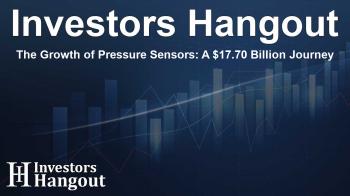The Growth of Pressure Sensors: A $17.70 Billion Journey

Future of the Pressure Sensor Market
The pressure sensor market is anticipated to flourish, poised to reach a remarkable USD 17.70 billion by 2030. This growth highlights the evolving technological landscape and increasing focus on advanced pressure monitoring solutions. In an era marked by the transition towards Industry 4.0, the importance of sophisticated pressure sensor technologies cannot be overstated.
Understanding Market Dynamics
The surge in demand for pressure sensors is significantly linked to the ongoing digital transformation across various industries. As manufacturing evolves with smart and interconnected systems, the requirement for prompt and accurate data has surged. The advent of the Industrial Internet of Things (IIoT), combined with artificial intelligence and cloud computing, has necessitated substantial improvements in pressure sensor technologies.
The Role of Industry 4.0
Industry 4.0 is not simply a buzzword; it is transforming production processes globally. With an increasing number of operational industrial robots, the reliance on precise sensors for monitoring and optimizing machinery has grown. Pressure sensors play a pivotal role in various industries, including oil and gas, pharmaceuticals, and chemicals, where maintaining pressure integrity is vital for compliance and safety.
Driving Forces Behind Market Growth
Several factors contribute to the burgeoning growth of the pressure sensor market. The automotive sector, in particular, is witnessing expansive demand for sophisticated pressure monitoring systems that enhance operational efficiency and safety. Pressure sensors help in managing a range of vehicle functions, further emphasizing their critical role in industry advancements.
Integration into Consumer Electronics
The integration of pressure sensors into consumer electronics is unlocking new growth horizons. Sensors now enhance the functionality of devices such as smartphones, wearables, and home appliances. For instance, in washing machines, pressure sensors monitor water levels, while they help maintain optimal airflow in air conditioning systems.
Segmentation of the Market
The pressure sensor market can be distinctly segmented based on connectivity, sensing method, and application areas. Wired pressure sensors have significantly dominated the market due to their reliability in critical applications. Industries depend heavily on these sensors, particularly where electromagnetic interference poses a risk.
Medical Sector Growth
Looking ahead, the medical segment is expected to hold the largest share of the market. As the demand for accurate patient monitoring increases, pressure sensors will become integral to medical devices. Their role in devices like ventilators and infusion pumps showcases their importance in safeguarding patient health and improving care outcomes.
Regional Insights and Projections
The Asia Pacific region is set to witness explosive growth in pressure sensor usage between now and 2030. This expected rise is fueled by rapid industrialization, evolving automotive manufacturing, and growing investment in consumer electronics. Countries such as China and India are leading the charge, reflecting a significant shift towards smart technology adoption in various sectors.
Challenges and Opportunities
While the growth trajectory appears promising, challenges like tightening profit margins and heightened competition must be navigated. However, opportunities are rich as advanced technologies improve sensor capabilities, paving the way for innovative applications and increased market penetration.
Key Players in the Market
Several key players are setting the pace in the pressure sensor market. Firms such as Honeywell International Inc., ABB, and Emerson Electric Co. are at the forefront, driving innovations and enhancing market competitiveness. Their contributions are pivotal in shaping the future landscape of the pressure sensor industry.
Frequently Asked Questions
What is the projected market size for pressure sensors by 2030?
The pressure sensor market is projected to reach USD 17.70 billion by 2030.
What factors are driving growth in the pressure sensor market?
Key drivers include advancements in Industry 4.0, the automotive sector's growth, and integration into consumer electronics.
Which segment is expected to witness the highest growth?
The medical segment is poised for significant growth due to the increasing demand for precise monitoring in healthcare devices.
Why are wired pressure sensors preferred in critical applications?
Wired sensors offer reliable data transmission and accuracy in environments prone to electromagnetic interference.
What regions are leading the growth in pressure sensor adoption?
Asia Pacific is expected to dominate the market, fueled by industrialization and tech advancements in manufacturing.
About The Author
Contact Henry Turner privately here. Or send an email with ATTN: Henry Turner as the subject to contact@investorshangout.com.
About Investors Hangout
Investors Hangout is a leading online stock forum for financial discussion and learning, offering a wide range of free tools and resources. It draws in traders of all levels, who exchange market knowledge, investigate trading tactics, and keep an eye on industry developments in real time. Featuring financial articles, stock message boards, quotes, charts, company profiles, and live news updates. Through cooperative learning and a wealth of informational resources, it helps users from novices creating their first portfolios to experts honing their techniques. Join Investors Hangout today: https://investorshangout.com/
The content of this article is based on factual, publicly available information and does not represent legal, financial, or investment advice. Investors Hangout does not offer financial advice, and the author is not a licensed financial advisor. Consult a qualified advisor before making any financial or investment decisions based on this article. This article should not be considered advice to purchase, sell, or hold any securities or other investments. If any of the material provided here is inaccurate, please contact us for corrections.

